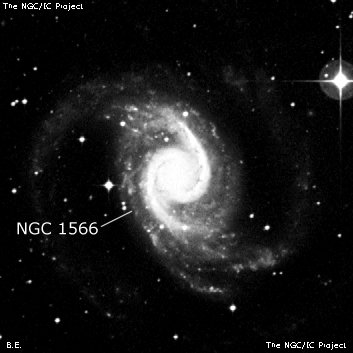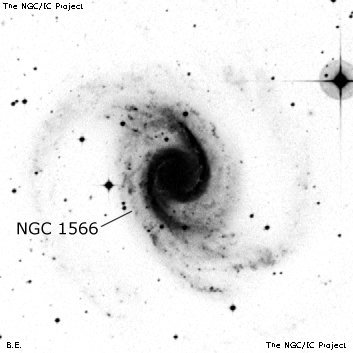NGC/IC Project Restoration Effort
(This is a very very beta version)
NGC1566


Basic Information
Location and Magnitude
Right Ascension: 4:20:0.5
Declination: -54:56:14
Constellation: DOR
Visual Magnitude: 9.7
Historic Information
Discoverer: Dunlop
Year of discovery: 1826
Discovery aperture: 9.0
Observational
Summary description: B, vL, vg, svmbM, 15s d in RA
Sub-type: SBbc
Steve's Notes
=====
NGC 1566
24" (11/18/12 - Magellan Observatory, Australia): at 260x, this gorgeous spiral was a showpiece treat even with a 4.5-day moon well up in the west. NGC 1566 is strongly concentrated with a very bright, elongated 1' core region that increases to an intense, round, 20" nucleus. The two spiral arms were easily visible with direct vision. The "southern" arm is attached on the north side of the core, wrapping around the core counterclockwise on the east side (passing directly between the core and a mag 12 star 2' E of center) and spiraling around 180¡ to the south side of the halo. On the south end, the arm passes just north of a mag 15 star and ends at a slightly brighter mag 14.5 star. The "northern" arm is attached on the south side of the core and wraps around the west side, gradually unfurling towards the north side and ending over 2' NNE of center.
With careful viewing, the northern arm "resolved" into 4 distinct extended HII regions, identified as NGC 1566:[HP80] I, II, IV and VI in Hawley and Phillips 1980 paper "Spectrophotometry of H II regions and the nucleus of NGC 1566" in ApJ, 235, 783. NGC 1566:[HP80] VI is a 12" knot in the arm, 45" due west of center and is clearly resolved from [HP80] IV, a slightly larger 15" knot which is 50" WNW of center. [HP80] II is a distinct 10" knot, just over 1' NNW of center and the faintest is [HP80] I, just to its north. The arm passes just south of a mag 14 star 2' N of center. With averted vision, the outer halo extends beyond the main arms, increasing the size to 5'x3' SSW-NNE. Mag 8.7 HD 27713 lies 5.4' NW. NGC 1566 is the largest and most luminous member of the Dorado Group, which contains three subgroups: NGC 1433 group, NGC 1672 group and NGC 1566 group.
13.1" (2/19/04 - Costa Rica): this Seyfert galaxy is a member of the Dorado Group and appears bright, large, elongated 3:2 ~N-S. With careful viewing the halo extends to ~3'x2'. A spiral arm is attached on the west side and curves towards the north beyond the main body of the galaxy. On the eastern side a low surface brightness arm is attached (on an E-W line with a mag 12 star close following the galaxy) and extends a little to the south on the eastern side of the main body. I was surprised to see the spiral arms so clearly! Mag 8.2 HD 27713 lies 5.4' NW of center and a mag 9.9 star lies in the field 9' W. NGC 1581 lies 40' E.



